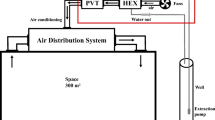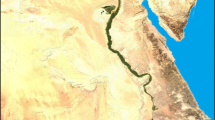Abstract
The building sector accounts for more than 40% of the global energy consumption. This consumption may be lowered by reducing building energy requirements and using renewable energy in building energy supply systems. Solar air-conditioning systems (SACS) are a promising solution for the reduction of conventional energy in buildings. The storage, especially the cold storage, plays an important role in SACS for unstable solar irradiation. In this paper, we took the absorption refrigerating unit as an example, and the solar air-conditioning system of an office building in Beijing was simulated. The accuracy of this model was verified by comparing with the SACS operation data. Moreover, based on the simulation data, the cold storage capacity of the solar air-conditioning system in different climatic regions was studied. The cold storage capacities of SACS in 20 cities distributed in different climate regions were studied systematically. The results simulated by our proposed model will be beneficial to the SACS design, and will enlarge the application of SACS.
Similar content being viewed by others
References
Aman J., Ting S.K., Henshaw P., Residential solar air conditioning: Energy and exergy analyses of an ammonia-water absorption cooling system. Applied Thermal Engineering, 2014, 62(2): 424–432.
Gude V.G., Energy storage for desalination processes powered by renewable energy and waste heat sources. Applied Energy, 2015, 137: 877–898.
Liu Z., Li H., Liu K., et al., Design of high-performance water-in-glass evacuated tube solar water heaters by a high-throughput screening based on machine learning: A combined modeling and experimental study. Solar Energy, 2017, 142: 61–67.
Li H., Liu Z., Liu K., et al., Predictive power of machine learning for optimizing solar water heater performance: The potential application of high-throughput screening. International Journal of Photoenergy, 2017, 2017: 1–10.
Li H., Tang X., Wang R., et al., Comparative study on theoretical and machine learning methods for acquiring compressed liquid densities of 1,1,1,2,3,3,3-Heptafluoropropane (R227ea) via song and mason equation, support vector machine, and artificial neural networks. Applied Sciences, 2016, 6(1), 25.
Li H., Liu Z.J., Performance prediction and optimization of solar water heater via a knowledge-based machine learning method. Handbook of Research on Power and Energy System Optimization, IGI Global, Pennsylvania, 2018, pp. 55–74. DOI: https://doi.org/10.4018/978-1-5225-3935-3.ch002
Charvát P., Klimeš L., Ostrý M., Numerical and experimental investigation of a PCM-based thermal storage unit for solar air systems. Energy & Buildings, 2014, 68: 488–497.
Wilbur P.J., Mitchell C.E., Solar absorption air-conditioning alternatives. Solar Energy, 1975, 17(3): 193–199.
Ward D.S., Solar absorption cooling feasibility. Solar Energy, 1979, 22(3): 259–268.
Al-Homoud A.A., Suri R.K., Al-Roumi R., et al., Experiences with solar cooling systems in Kuwait. Renewable energy, 1996, 9(1–4): 664–669.
Best R., Ortega N., Solar refrigeration and cooling. Renewable Energy, 1999, 16(1–4): 685–690.
Florides G.A., Kalogirou S.A., Tassou S.A., et al., Modelling and simulation of an absorption solar cooling system for Cyprus. Solar Energy, 2002, 72(1): 43–51.
Assilzadeh F., Kalogirou S.A., Ali Y., et al., Simulation and optimization of a LiBr solar absorption cooling system with evacuated tube collectors. Renewable Energy, 2005, 30(8): 1143–1159.
Ghaddar N.K., Stratified storage tank influence on performance of solar water heating system tested in Beirut. Renewable Energy, 1994, 4(8): 911–925.
Lavan Z., Thompson J., Experimental study of thermally stratified hot water storage tanks. Solar Energy, 1977, 19(5): 519–524.
Mather D.W., Hollands K.G.T., Wright J.L., Single-and multi-tank energy storage for solar heating systems: fundamentals. Solar Energy, 2002, 73(1): 3–13.
Rosiek S., Garrido F.J.B., Performance evaluation of solar- assisted air-conditioning system with chilled water storage (CIESOL building). Energy Conversion and Management, 2012, 55: 81–92.
Helm M., Keil C., Hiebler S., et al., Solar heating and cooling system with absorption chiller and low temperature latent heat storage: energetic performance and operational experience. International Journal of Refrigeration, 2009, 32(4): 596–606.
Wang J., The characteristics of solar powered refrigeration system with energy storage technology during an air- conditioning season. Dalian university of technology, Dalian, China, 2012.
Wang X.L., Phase change cold storage and its application in solar energy air-conditioning system. Shanghai Jiao tong University, Shanghai, China, 2013.
Bu G.F., Jin S.M., Study on the characteristics of the system of multistage heat storage tanks applied to the solar air-conditioning. Fluid Machinery, 2013, 41(11): 76–80.
Wan Z.M., Shu S.M., Hu X.H., Research of energy storage in novel solar with absorption air-conditioning system. Refrigeration and air-conditioning, 2006, (01): 36–39.
Lu X.R., Wang Z.J., Yang C.B., Design of storage tank of solar air-conditioning. Energy-saving Technology & Measure, 2009, 37(9): 63–65.
Meng L.Y., The research on the absorption refrigerating/heat pump system combined solar and traditional energy in villas. Dalian university of technology, Dalian, China, 2005.
Sun Z., Zhao Y., Xu W., et al., A solar heating and cooling system in a nearly zero-energy building: A case study in China. International Journal of Photoenergy, 2017, 2017, Article ID 2053146.
Almeida P., Carvalho M.J., Amorim R., et al., Dynamic testing of systems-use of TRNSYS as an approach for parameter identification. Solar Energy, 2014, 104: 60–70.
Liu Z., Xu W., Zhai X., et al., Feasibility and performance study of the hybrid ground-source heat pump system for one office building in Chinese heating dominated areas. Renewable Energy, 2017, 101: 1131–1140.
Liu Z., Li H., Cao G., Quick estimation model for the concentration of indoor airborne culturable bacteria: an application of machine learning. International Journal of Environmental Research and Health, 2017, 14(8): 857.
Ávila D.S.G.M., Biek D.I.K., Wiencke C., Technical and economic assessment of the integration of refrigeration concepts into the proceeding extension of solar energy systems in Brazil. http://monografias.poli.ufrj.br/monografias/monopoli10018743.pdf (accessd on 10 May 2018)
Yang Z., Chen H., Wang L., et al., Comparative study of the influences of different water tank shapes on thermal energy storage capacity and thermal stratification. Renewable Energy, 2016, 85: 31–44.
Liu J.H., Liu R.H., Wang C.H., et al., Thermodynamic test for composite phase change material of Na2SO4·10H2O energy storage system. Energy Conservation, 2007, 26(9): 13–14.
Acknowledgement
This work was funded by the National Key R&D Program of China (No. 2017YFC0702600).
Author information
Authors and Affiliations
Corresponding author
Rights and permissions
About this article
Cite this article
Sun, Z., Zhao, Y., Xu, W. et al. Cold Storage Capacity for Solar Air-Conditioning in Office Buildings in Different Climates. J. Therm. Sci. 28, 1195–1204 (2019). https://doi.org/10.1007/s11630-019-1067-y
Received:
Published:
Issue Date:
DOI: https://doi.org/10.1007/s11630-019-1067-y




